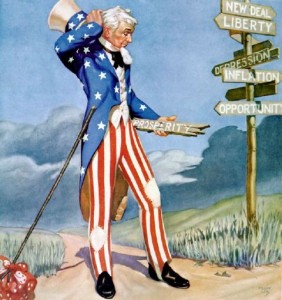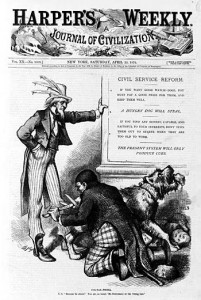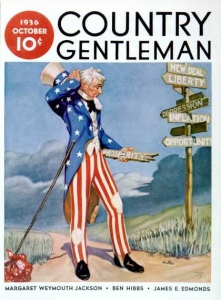
Frank Lea (1904-1986)|Which Way to Prosperity?, c. 1936|Cover illustration of The Country Gentleman (October 1, 1936)
One of the things that causes me to feel hopeful is that we are able to laugh at ourselves in the face of difficulties. During the middle of the great depression, the magazine Country Gentleman used a work by Frank Lea called Which Way to Prosperity? for its cover illustration The image is of Uncle San standing at a cross-roads holding the sign-board for “prosperity” in his left hand and scratching his head with his right, his kerchief wrapped satchel hung from a long stick is resting on the ground instead of being balanced on his right shoulder and held in place with his right hand. The sign for prosperity is warped and worn and appears to have been picked up off the ground, unlike the other signs (new deal, liberty, depression, inflation, and opportunity) still attached to the post but pointing in different directions. Having lifted his top hat off his head, Uncle Sam scratches it in puzzlement as he wonders which way the sign for prosperity pointed.

Thomas Nast (1840-1902)|Cur-Tail-Phobia about Civil Service Reform|Cover illustration for Harper’s Weekly (April 22, 1876)
Frank Lea’s costume for Uncle Sam is certainly more elaborate than it’s predecessors: Lea modified Uncle Sam’s traditional top hat and tailcoat (see Thomas Nast’s version of Uncle Sam above) into star studded garments turning the late 18th century clothing into a walking translation of the stars and stripes. It is interesting to note that this 1936 version continues to construct the character’s breeches with attached stirrups worn over the shoes and tucked between the heels and sole’s of Sam’s boots. Honoré de Balzac’s described a tippler in his novel The Bureaucrats as wearing “breeches with stirrups that extended beyond the buckles . . . .” which is what we see in Nast’s version of Uncle Sam. While Lea’s Uncle Sam is dressed beyond the traditional in his stars and bars suit, the knees of his britches clearly show that they’ve been worn past their prime since they have conspicuous large white patches on each leg.
While there is little detail to see in Frank Lea’s country landscape, it is interesting to note that in the far background and low to the horizon are a gathering of darkening clouds. This might indicate that the artist expected more troubled times ahead. In hindsight we know that by 1936 there were measurable gains toward recovery, but the real ending of the great depression did not take place until America’s entry into World War II in 1941. In this illustration the dark clouds are behind Uncle Sam in the direction indicated by the sign on the post labeled Depression, so it is more likely that those clouds are in the past. Since the way forward is not visible, we cannot know what is still ahead.
Little is known about the illustrator Frank Lea. While there is a short biography in AskArt.com there is no real information about his education as an artist or his work as an illustrator. Some other illustration images referenced through Google Images shows that his work has a tendency toward a rather cartoon-like approach.
Perhaps Frank Lea borrowed the idea for this illustration from the humanist allegory, Hercules at the Crossroads. In this moral fable, Hercules stands with his club at his side at a cross road where he is faced with choosing his direction. One path leads to the pleasure of instant gratification in the guise of Vice and the other leads to excellence by way of a difficult path in the guise of Virtue. Frank Lea’s Uncle Sam is similarly accompanied by his satchel hung from a stick, but instead of opposing choices, he is stumped by the plethora of choices in the signs. Unfortunately there is no direction that clearly leads to the obvious preferred choice, prosperity.
September 23, 2010
By Joyce K. Schiller, Curator, Rockwell Center for American Visual Studies
Norman Rockwell Museum







